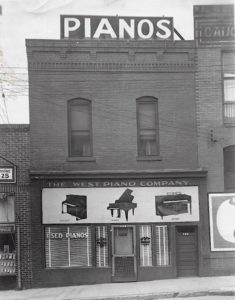The shopping area of Five Forks has had many incarnations. We know that commercial development of the area began between 1877 and 1890. Hagan’s Central Pharmacy was trading by that time.
Sanborn insurance maps from 1899 show the west side of Jefferson Street between Jefferson Avenue and Pine Street had three stores – numbers 402, 400½, and 400 – had two grocers and a tailor. The buildings there at the time were likely of frame construction. Before 1910, the building at 400 Jefferson Street was replaced by the present brick construction.
Also by 1910, Sanborn shows all these buildings contained grocers. Samuel Martin had his store at 400 Jefferson Street, which later passed to his son George. Charles Booth had 400½. The name of the grocer at 402 is not known
 George Martin at 400 was particularly creative. He also acquitted the home around the corner at 256 Jefferson Avenue and by 1920 had created a room connecting the rear of his store at 400 Jefferson Street to his home.
George Martin at 400 was particularly creative. He also acquitted the home around the corner at 256 Jefferson Avenue and by 1920 had created a room connecting the rear of his store at 400 Jefferson Street to his home.
By 1925, local grocers were feeling the pressure from national chains – particularly the Great Atlantic and Pacific Tea Company (A&P) and the Kroger Grocery and Baking Company. As a result, local grocers created an association called the Danville Community Stores with as many as 70 participating retailers. Each of these stores had a yellow front or yellow band in their windows and advertised name brand products, superior service, and the lowest possible prices. All the Five Forks grocers participated, but the association failed in 1927 – the same year A&P opened a store nearby at 483 Jefferson Street. And Kroger opened a store in the former Central Pharmacy – a self-service store – about 1935.
In addition to the residential areas once on Jefferson, Loyal, and Wilson Streets, Five Forks businesses acquired new traffic when the General Hospital building just around the corner was converted to apartments. First was the Fairfax Apartments (10 units) in 1926 and then the Madison Apartments (18 units) in 1928. Various local grocers continued in these buildings until the 1960s. Meanwhile, the national chains opened larger stores known as supermarkets in other locations.
Sometime in the late 1920s, the frame building numbered 402 – at the corner with Pine Street – was replaced by the present brick structure with stores numbered 406 and 404 and two apartments above. This was about the same time as the new gas station and stores fronting Loyal Street were constructed by the Jefferson Avenue Improvement Corporation. The new 406 Jefferson Street hosted more grocers – first the Shell Grocery Company and then Bennett H. Lovell. This is the same building presently being rehabilitated including new storefront windows.

In 1939, the building at 400 Jefferson Street – once George Martin’s grocery, was replaced by the West Piano Company. That business operated for two generations into the 1990s. The building, along with the neighboring 260 Jefferson Avenue, received a new roof in 2018.
Around 1945, Booth’s grocery at 400½ was replaced by Pattisall’s Confectionery – a candy store. The candy store remained until the mid-1960s. Only a false façade remains at the location today.
The west side of Jefferson Street at Five Forks is now ripe for redevelopment. With its proximity to the burgeoning River District and the revitalization of the Old West End, we expect exciting new changes soon.
